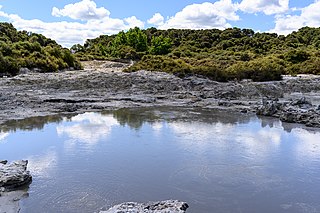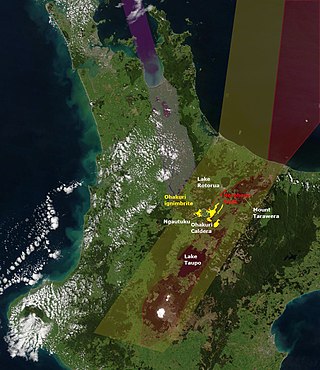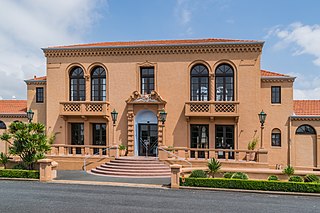
Rotorua is a city in the Bay of Plenty Region of New Zealand's North Island. The city lies on the southern shores of Lake Rotorua, from which it takes its name. It is the seat of the Rotorua Lakes District, a territorial authority encompassing Rotorua and several other nearby towns. Rotorua has an estimated resident population of 58,900, making it the country's 12th largest urban area, and the Bay of Plenty's second-largest urban area behind Tauranga.

The Rotorua Caldera is a large rhyolitic caldera that is filled by Lake Rotorua. It was formed by an eruption 240,000 years ago that produced extensive pyroclastic deposits. Smaller eruptions have occurred in the caldera since, the most recent less than 25,000 years ago. It is one of several large volcanoes in the Taupō Volcanic Zone on the North Island of New Zealand.

Lake Rotorua is the second largest lake in the North Island of New Zealand by surface area, and covers 79.8 km2. With a mean depth of only 10 metres it is considerably smaller than nearby Lake Tarawera in terms of volume of water. It is located within the Rotorua Caldera in the Bay of Plenty Region.

Mercury NZ Limited is a New Zealand electricity generation and multi-product utility retailer of electricity, gas, broadband and mobile telephone services. All the company's electricity generation is renewable. Mercury has a pre-paid electricity product sub-brand GLOBUG. Mercury Energy is also the largest electricity retailer in New Zealand.

Geothermal power in New Zealand is a small but significant part of the energy generation capacity of the country, providing approximately 17% of the country's electricity with installed capacity of over 900MW. New Zealand, like only a small number of other countries worldwide, has numerous geothermal sites that could be developed for exploitation, and also boasts some of the earliest large-scale use of geothermal energy in the world.

The Te Mihi Power Station is a 166 MW geothermal power station owned and operated by Contact Energy, located north of Taupō in New Zealand.

The New Zealand Māori Arts and Crafts Institute (NZMACI) is an indigenous traditional art school located in Rotorua New Zealand. It operates the national schools of three major Māori art forms.

Pōhutu Geyser is a geyser in the Whakarewarewa Thermal Valley, Rotorua, in the North Island of New Zealand. The geyser is the largest in the southern hemisphere and among the most active in the area, erupting up to twenty times per day at heights of up to 30 m (98 ft). The name Pōhutu is derived from te reo Māori, although it has an unclear etymology – being translated as either 'big splash', 'explosion' or 'constant splashing'.

Tikitere, also known as "Hell's Gate", is a suburb in Rotorua's most active geothermal area on State Highway 30, between Lake Rotorua and Lake Rotoiti in the Bay of Plenty, New Zealand. It includes many geothermal features such as steaming lakes, mudpools, fumaroles, a mud volcano and the Kakahi Falls, the largest hot waterfall in the southern hemisphere.
Located in a geologically active region, New Zealand has numerous geothermal features, including volcanoes, hot springs, geysers and volcanic lakes. Many of these features cluster together geographically, notably throughout the central North Island's Taupō Volcanic Zone. These areas attract scientific interest and tourism; power generators, industry and civil engineering also utilise them.
The region around the city of Rotorua, in New Zealand's North Island, contains several lakes which have a total area of about 250 square kilometres. The term Rotorua lakes is ambiguous as it has been used historically for a New Zealand administrative area. From biggest to smallest, these are Lake Rotorua, Lake Tarawera, Lake Rotoiti, Lake Rotomā, Lake Okataina, Lake Rotoehu, Lake Rotomahana, Lake Rerewhakaaitu, Lake Rotokākahi, Lake Okareka and Lake Tikitapu. There are also smaller lakes including: Lake Okaro, Lake Rotokawa, Lake Rotokawau and Lake Rotongata. Most of the lakes have formed due to volcanic activity and some have current geothermal activity. The region is part of the Taupō Volcanic Zone, the world's most active area of explosive silicic volcanic activity in geologically recent time.
The Tauhara Power Station is a geothermal power station north of Taupō in New Zealand. Previously known as Tauhara 2, the project is being developed by Contact Energy and Tauhara Moana Trust and is expected to be operational in the third quarter of 2024.

The relatively small Rotomā Caldera is in the Taupō Volcanic Zone in the North Island of New Zealand.

The Ohakuri Caldera was formed in a paired single event eruption of Ohakuri ignimbrite and is located in the Taupō Volcanic Zone on the North Island of New Zealand. Its significance was first recognised in 2004, as the geology of the area had been misunderstood until then. The paired eruption resulted in a very large eruption sequence in the Taupō Volcanic Zone about 240,000 years ago that included the formation of Lake Rotorua and eruption of the Mamaku ignimbrite.

The Blue Baths is a heritage geothermal baths building in Rotorua, in the North Island of New Zealand. The building is designed in the Spanish Mission style. It is listed as a Category 1 Historic Place by Heritage New Zealand.












